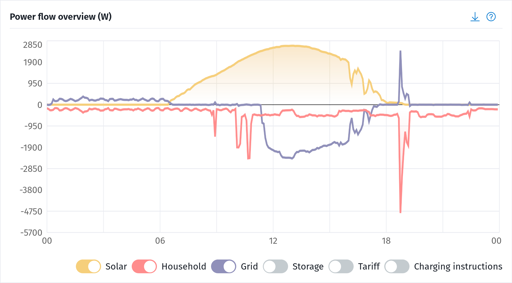Neat breakdown with data + some code.
To be fully self sufficient you have to meet your energy consumption during the most cloudy days in winter.
2 days storage gives you a 5% chance of a blackout at some point during the year.
4 days storage gives you a 1% chance of a blackout at some point during the year.
You will not get to 0%.
You will not get 0%.
I see we are including the nuclear winter scenarios!
Actually, I was thinking volcanos. They can reduce sunlight over a large area for prolonged periods.
We have a whole home generator that runs in natural gas. They’re not the quietest things. Been tossing around the idea of having batteries added so that when the power cuts we go to battery. Then when the battery gets low the generator cuts on just long enough to charge the batteries. Wash rinse repeat.
There was an article posted somewhere on Lemmy a few months back where someone tried to do similar calculations for the US as a whole. What I took from the result was 95% renewable was achievable and still cheaper than fossil fuels. However the over provisioning of renewables and over double the storage needed to reliably achievable 100% made that infeasible with today’s proving and technology. Basically you can install storage to cover when the sun is not shining but it’s much more difficult to cover weeks of gloominess
Solar isn’t the only renewable choice, though. It’s just the easiest to do on an individual level. Also, there are plenty of areas for which weeks of gloominess will never (on human timescales) be an issue.
they generate about 3,800kWh per year. We also use about 3,800kWh of electricity each year
Obviously, we can’t use all the power produced over summer and we need to buy power in winter. So here’s my question: How big a battery would we need in order to be completely self-sufficient?
O, god, it’s going to be huge. You really can’t do the off-grid thing unless you have enough power production to satiate you over any given 3-day moving window. Trying to store power from summer until winter is going to be too expensive, instead buy more panel.
This isn’t even going into the fact batteries lose charge slowly. So any power generated in summer will be much diminished by winter, even if you have big enough batteries.
Seems to me his panel capacity is to small anyway.
We have 11 kWh panels, and yes in the summer we routinely produce 4 times more than we use, and we have a 7.5 kWh battery But November December and January it’s not even close to enough.In the Winter you can easily have a week with near zero production:
Our Import / export from grid last year:
November 215 / 59 kWh
December 300 15 kWh
January 268 / 34 kWhDespite we have almost 3 times the capacity, and produce more than twice what we use per year, and we have a decent battery and believe it or not, even the shortest day we can produce enough power for a whole 24 hour day if it’s a clear day! But we can also have clouds for 14 days!
But for those months we imported 783 kWh and exported 108 that could have been used with bigger battery. But the net import was still 675 kWh!! For those 3 months, and that’s the minimum size battery we could have managed with, and then we even need 10% extra to compensate for charge/discharge losses.TLDR:
Minimum 740 kWh battery in our case, and that’s without heating, because we use wood pellets.That means it would require at least the equivalent of 10 high end fully electric car batteries. But also a very hefty inverter, which AFAIK ads about 50% the price of the battery.
PS: Already in February we exported more than we imported.
(Author here) As I say in my post, our roof is full. We have 16x 320 Watt panels - 8 on each side of the roof.
OK I didn’t see that, that’s bigger than I expected, we make about 12.5 MWh per year on our 11.2 kWh panels = 1.1 MWh per kWh capacity.
Your system is 5.1 kWh but you only make 3.8 MWh per year = 0.75 MWh per kWh capacity.
Meaning we have 50% higher yield per kWh rated capacity!So our production remains 3.3 times higher than yours, despite we only have twice the capacity.
But our panels are pretty optimally placed towards the south.Considering you are further south compared to us, I’m surprised your yield is so low, despite London is infamous for being cloudy.
Damn, those winter numbers mean full off-grid is quite difficult with pure solar. A propane or diesel generator to occasionally top off the batteries would be required for winter.
It is not remotely close to economically viable to go off grid, and the exports of solar power to the grid pay for the connection anyway.
The reason to have a battery is that it lasts through the night, or even with a smaller system, it can handle dinner time, which is the most expensive time of day to buy electricity.
Now if you live in some remote area without a grid, a generator is a way better option than a huge battery.
Maybe if you live somewhere very sunny, like Spain and especially southern parts of USA you can probably do it with a modest battery that can handle a couple of days.
In the summer we can make enough electricity on by far the most cloudy days, but in the winter, the sun can’t penetrate the clouds nearly as well.
Admittedly London is south of where I live, which is close to the most southern part of Denmark, but on the other hand London is infamous for grey weather with heavy clouds.
they generate about 3,800kWh per year. We also use about 3,800kWh of electricity each year.
Holy shit. I think we used that much last month, which is higher than average but not that high for August around here.
glad I’m not the only one that noticed that.
last time I checked I was using around 4600-5800kwh from May to August. the rest of the year its 3300-4200.
I live in a dual zoned 5200sqft home and my average power bill is around $900.
I’ve had solar sales try to talk me into solar panels but once they see my consumption they stop answering my calls lol. could be because I told them I’ll buy once I can get net zero.
could be because I told them I’ll buy once I can get net zero.
I’m not following your logic. You aren’t willing to accept any savings unless you can completely zero out your power bill? Judging from your consumption I’m assuming a good chunk of that is for cooling your home? If so that means you’re likely in a pretty great place to harvest solar power. You’d reach payback of your investment on your array much faster than most, and be saving money for probably 35 years or more with little to no additional investment.
Making some guesses for how much your electricity rates are, and how much you’re consuming (assuming much from cooling), you might be a full payback in less than 7 years if you took advantage of the tax credit. Then, every month after that you’d be gaining money back.
my house is over 120 years old. it still has knob and tube in half the house. I have even found gas lines for the old sconces, that were “conveniently” used as grounds for said knob and tube in some places. the house is a nightmare, electrically speaking. the only new-ish electrical are the HVAC systems, the 200amp panel, and the basement (where the rack lives).
for me to get proper solar installed, it would cost more than the house cost to buy. For me to find it in any way cost effective, I would need my $900 a month power bill to pay for the $200k loan on top of my mortgage.
That house sounds like a terrible investment.
You leave 5,278 LED light bulbs on 24/7?
…maybe.

As is mentioned in the article 😉 What is also mentioned is the fact that battery prices are going down. Soon it seems they’ll be down to $10/kWh!
There’s also alot of new battery tech on the way.
There will be a market for batteries at home, and they will exist with the best suitable tech for it - and it’s probably not lithium.
How many years, I dont know. What will it be, and who will do it, no clue. Otherwise my stock portfolio would look better if I knew these things haha.
Basically why the grid exists to begin with. You’re not supposed to be solving these engineering problems on a household budget inside a single home.
You’d be better off simply reducing your consumption or finding alternative methods of power (nat gas or maybe wind or geothermal) during the longer winter nights.
If you really want to go crazy, you should consider investing in a bigger home with better insulation and roommates. An apartment/condo block can at least leverage economies of scale, if you’re dead set on DIY. More people benefiting from the setup dilutes the cost per person.
I recently got a solar system and came to the conclusion that if you can sell power back to the grid (not everyone can) for some reasonable percentage of what it costs to buy it, then it will always be worth it to be connected (assuming you already are).
Quite simply, if you have enough solar capacity to get you through the winter (no house is going to have months of battery storage), then you will always be creating far more than you need in the summer. Selling this excess will easily cover any costs associated to being on the grid.
Also at current prices batteries are good for backup power only, it’s always cheaper to sell excess power to the grid in the day and buy it back at night than it is to have battery capacity to get through the night. I worked out it would take 40 years for our battery to pay for itself (assuming the battery kept a constant battery capacity for 40 years…) but less than 10 years for the rest of the system to pay for itself.
I’m paying 50c per kWh for grid…its bad. And that’s if I don’t go over the limit. There’s 4 teirs so it gets more expensive per tier.
Wait, it gets more expensive when you use more?
Exceptionally. Yes.
Something very important that anti-nuclear but otherwise environmental minded people should realize is this sentence: " There’s no practical way to build domestic batteries with this capacity using the technology of 2025."
Also applies to grid storage. There does not exist a chemical energy storage solution that can substitute for “baseload” power. It’s purely theoretical much like fusion power. Sure maybe in 50 years, but right now IT DOESN’T EXIST. Economically, practically, or even theoretically.Why do I bring this up? Because I’ve seen too many people think that solar and wind can replace all traditional power plants. But if you are anti-nuclear, you are just advocating for more fossil fuels. Every megawatt of wind or solar, has a megawatt of coal or gas behind it and thus we are increasing our greenhouse gas emission everytime we build “green” generation unless we also build Nuclear power plants. /soapbox
It’s very infuriating talking to people about this because they never really accept that nuclear power is necessary. They spend all their time complaining about how it’s dangerous (it isn’t) and how it’s very expensive, and how you don’t have a lot of control over its output capacity. And yeah, all of those are true, but so what, the only other option is to burn some dead trees which obviously we don’t want to do.
Just because nuclear has downsides doesn’t mean you can ignore it, unless of course you want to invent fusion just to spite me, in which case I’ll be fine with that.
The new tack is to conflate nuclear energy with fossil fuels. As in assuming that nuclear energy is “legacy” power generation, and that obviously we need to use modern gernation like solar and wind, and magical grid-level storage technologies that don’t exist. Also ignore that baseload power is still required, and is currently fulfilled with Natural Gas and Coal.
There is absolutely nothing required about baseload power. It’s there because the economics of generating power favored it in the past. You could build a baseload plant that spits out a GW or so all day, everyday for relatively cheap.
That economic advantage is no longer there, and no longer relevant.
Well you still need baseload. You can’t forget about it just because it’s inconvenient.
No, you don’t. It’s entirely an accounting thing.
Honestly it’s like talking to a conspiracy theorist.
What are you talking about, what’s “an accounting thing” do you even know what base load is? Go look up brownouts, actually for that matter go look up the term baseload because I don’t think you’re using it right
You don’t need baseload. You need to follow the duck curve of demand.
You had baseload because those plants used to be the cheapest one you could find. That’s not true anymore, and the model needs to shift with it.
https://www.nrdc.org/bio/kevin-steinberger/debunking-three-myths-about-baseload
In the past, coal and nuclear were perceived to be the cheapest resources, and the prior electricity system structure relied upon large power plants without valuing flexibility. Today, low natural gas prices, declining renewables costs, flat electricity demand due to more efficient energy use, and stronger climate and public health protections are all driving an irreversible shift in the underlying economics of the electricity industry. As a result, the term “baseload”—which historically has been used to refer to coal and nuclear plants—is no longer useful.
Well, unfortunately some people are using nuclear as an excuse to argue that we don’t need any renewables at all and that they should be banned entirely. They do this because they know that nuclear faces extreme regulatory and societal challenges and it would allow coal, diesel and gas to continue unabated.
So it creates a backlash where renewable advocates feel they have to fight nuclear to survive.
That is completely wrong, and only shows you haven’t kept up with developments in storage.
Show it. Tell me where the grid-level storage exists for a city like Tokyo, or NYC, or Chicago, or Mexico City, or Paris, or London. Hell pick your own city, show me where it exists right now today.
See, that’s a trap that keeps the argument within a frame where you can win. That’s not how it works.
What you’re doing is focusing on a singular solution, and then showing why it can’t solve all the problems. Each individual solution is attacked on its own, and then nuclear ends up being the only option.
Except that’s a dumb way of going about it.
Each of these solutions has pros and cons. You use the pros of one to cover the cons of another.
As one example I mentioned elsewhere in the thread, Brazil has an HDVC line 2400km long. With that kind of reach, solar in Arizona can power Chicago, wind in Nebraska can power New York, and every single existing hydro dam along the way can provide storage. What you end up with is the possibility of not needing to build a single MWh of new storage or hydro dams. If nothing else, you don’t need very much. Long distance transmission is thus very important, but it tends to get left out of these discussions because it’s boring.
I’ll leave you with an excerpt from “No Miracles Needed”, written by Mark Z Jacobson, a professor of civil and environmental engineering:
On July 11, 2011, I was invited to a dinner at the Axis Café and Gallery in San Francisco to discuss the potential of renewable energy as an alternative to natural gas hydrofracking in New York State. Little did I know it at the time, but that dinner would set off a chain reaction of events that turned a scientific theory, that the world has the technical and economic ability to run on 100 percent clean, renewable energy and storage for all purposes, into a mass popular movement to do just that. The movement catalyzed an explosion of worldwide country, state, and city laws and proposed laws, including the Green New Deal, and business commitments. Ten years after that meeting, critics were no longer mocking our ideas as pie-in-the-sky and tooth-fairy-esque. They were no longer claiming that transitioning to more than 20 percent renewables would cripple power grids. Instead, the discussion had changed to what is the cost of 100 percent renewables, how fast can we get there, and should we leave a few percent for non-renewables?
This was from the first edition of the book published in 2023. So quite contrary to your claim that “there’s no practical way to build domestic batteries with this capacity using the technology of 2025”, the technology has existed for over a decade. We just need to build it. And we are building it, just not as fast as we need to.
Meanwhile, the NRC continues to stamp permits for new nuclear, but nobody is building. There’s a reason for that, too.
I can dismiss the the other solutions that are worse then pumped hydro because pumped hydro is actually the best case scenario for grid-level storage and it requires A LOT of space. Anything else, batteries, pneumatic mines etc etc are going to be worse in terms of space by orders of magnitude, not to mention the actual costs. Hand waving the need for grid-level storage by saying we would us hydro shows you don’t understand the scale of the problem.
That excerpt from that engineer is great, but WHERE IS THE STORAGE? Show it to me on a map. You can’t because it does not exist. New Nuclear plants are being built, finally, but there is a reason that no grid-level storage exists. It’s literally not possible today. There exists a pilot battery plant in Australia, and there exists a few megawatts of storage in Scotland, but these are few and far between and none of them are suitable for massive deployment.
I can dismiss the the other solutions that are worse then pumped hydro because pumped hydro is actually the best case scenario for grid-level storage and it requires A LOT of space.
It’s like you didn’t even read the bit about how HVDC makes this a non-issue.
. . . but WHERE IS THE STORAGE? Show it to me on a map. You can’t because it does not exist.
It’s in every hydro dam that’s already built in between Arizona and New York. If we even do need more, there is plenty of land to use.
How about this: I throw out everything I said about synergizing different solutions. We just have solar and storage. No long distance transmission or wind. How much does that cost to power a city?
That study has been done. Going by Lazard’s levelized cost of energy 2025 report, the most optimistic cost to build new nuclear is $141/MWh–and keep in mind that I’m giving nuclear the best case scenario here. A solar+storage solution that would provide 97% of the power needed for Las Vegas would cost $104/MWh. “But that’s sunny desert with lots of empty land around it”, I hear you say. The bigger deal is that Washington DC could have 81% of power done at $124/MWh. Northern city where it snows a lot, and it’s still more viable than nuclear.
“But 81% isn’t 100%”. No, please stop. You get to 81% before you get to 100%. This isn’t even the best way to get to 100%.
This study has a comprehensive wind/water/solar solution fighting with two arms tied behind its back, and it’s still kicking nuclear’s ass.
. . . New Nuclear plants are being built, finally
Nope, not in the US, they aren’t.
Here’s a map of NRC licenses. The green pips are the ones where licenses are already approved. Here’s the list and where they are at:
- William States - Licensed to go ahead in 2016. Canceled in 2017 with a contributing factor being the bankruptcy of Westinghouse (which itself happened because of cost overruns at the Vogtle nuclear plant build)
- Turkey Point - Licensed new builds in 2018. No news on actually going forward.
- North Anna - Licensed new builds in 2017. No news on actually going forward.
- PSEG - Issued an early site permit, but not the full license. The ESP was set in 2016 with no movement noted since then.
- Fermi - This was licensed just in the past few months. They want to have it in operation by 2032, which, lol, no it isn’t.
That’s not a list of success stories. Add the Vogtle debacle to the list and it’s all a bucket of failure.
The AP1000 design at Vogtle was supposed to prevent the need for botique engineering that had been a problem with reactors in the past. You could use one design everywhere. That was hoped to prevent all these cost and schedule overruns. It didn’t. In addition to Vogtle, it was also built in China at the Sanmen and Haiyang plants. Like Vogtle, Sanmen went over budget and over schedule, but managed in the end. There’s less information about what happened at Haiyang, but the timeline of beginning construction and reaching first criticality is roughly the same as Sanmen; we can assume it went about the same.
There’s a very clear reason why this is happening, and it comes down to this chart:
https://energyskeptic.com/wp-content/uploads/2024/03/Why-large-projects-fail-Flyvberg.jpg
This is a list of megaprojects and their tendency to go overbudget. Everything from rail to mining to airports. The third worst budgetary offender is nuclear power at a mean cost overrun of 120%. It managed to be better than Olympic Games, at least. The very worst is the related issue of nuclear storage at a whopping 238% mean budget overrun.
Way down at the bottom, you will find solar, power transmission, and wind. Solar projects have a mean overrun of 1%, energy transmission 8%, and wind 13%.
That should make it very clear why the list above has approved licenses with no actual movement. Who the hell would want to put their money into that? You can invest in wind or solar, have a very good chance of it staying within budget, and it will be making revenue within 6-12 months. You put that in nuclear, and you better hope that other investors will pitch in when the budget doubles, or else you have to do it if you hope to see your money again. In the very best case scenario, you’re not going to see a cent of revenue for at least 5 years, but probably more like 10.
Meanwhile, old nuclear is being taken offline because it’s too expensive. If it’s not even worthwhile to keep what we have, what hope is there for building new?
It’s not a matter of regulation, either. The industry would really like it to be, but they’ve been putting their thumb on that scale for a while now. Even with that, nobody wants to finance this shit.
It’s not just that nuclear is expensive. It’s a boneheaded thing to drop money into at all.
Pumped hydro exists.
Do some quick math. How much pumped hydro in terms of acre-feet would be required to power a hypothetical city like Chicago at night? Where would this theoretical reservoir be built?
acre-feet
I can’t stop laughing at this as a unit of measurement
I guess if you don’t understand units of water per area, then there is no reason to expect you to be able to do any kind of critical analysis about why “pumped hydro” is a problem.
I am not American, so why would I use an American unit of measurement?
You can use whatever moon-units you want. I prefer to use people-centric units.
Ok, if you want an approximate American unit equivalent to a megalitre think of it as cube that can fit a blue whale
That’s a completely unnecessary way to do things. The mistake you’re making is that this specific way must provide all power.
It doesn’t. You combine methods for a reason. The wind blows at times when the sun isn’t shining, and vice versa. We have weather data stretching back many decades to tell us how much a given region will give us of each. From there, you can calculate the maximum lull where neither is providing enough. Have enough storage to cover that lull, and double it as a safety factor.
Getting to 95% water/wind/solar with this method is relatively easy and would be an extraordinary change. Getting all the way to 100% is possible, just more difficult.
Do the math, how much grid-level storage do you need to power a city like chicago assuming zero baseload generation.
First of all nuclear energy is a fossil fuel.
Yikes. If words have no meaning, then sure. But there is no world where radioactive elements that come from stars have anything to do with fossil fuels that come from decayed biomass.
I’m pro-nuclear energy in theory. But I’ve got to ask - where do you get them spicy rocks from? Do you have to dig them up from a mine? Do they regularly replenish themselves? Does the energy generation have to be constantly checked for pollution leaks?
OK, they may not literally be fossilised bio-matter - but the end result is pretty much the same. Scar the landscape as you dig, release pollutants as you refine, hope you don’t run out of material, make sure someone else pays to clean up the mess.
Yes mining still exists. Unlike how Solar Panels and Wind Turbines grow like plants and replenish year over year with no other industrial process required right?
But again, you don’t appreciate the energy density that is contained in a reactor fuel. The volume of material is minuscule compared to coal. While oil/gas are a lot better then coal energy density-wise, they have the significant downside of greenhouse gases and causing global warming.
What I want to do is find out what the maximum size battery I would need in order to store all of summer’s electricity for use in winter.
I mean, I think that it’s probably not a good idea for this guy to try to go fully off-grid if he has access to the grid, but for the sake of discussion, if one were honestly wanting to try it and one is in the UK, I’d think that one is probably rather better off adding a wind turbine, since some of the time that the sun isn’t shining, the wind is blowing.
https://www.statista.com/statistics/322789/quarterly-wind-speed-average-in-the-united-kingdom-uk/
Wind speed averages in the United Kingdom are generally highest in the first and fourth quarters of each calendar year – the winter months.
The UK is one of the worst places in the world in terms of solar potential:
https://globalsolaratlas.info/
But it’s one of the best in terms of wind potential:
I could probably get away with putting solar panels on my roof but I think my neighbours would have something to say about a wind turbine. They’re pretty loud.
Ugh! Just tell your neighbors to shut up or at least keep it down.
Small wind turbines are really, really poor. You need to go high to access the good air-streams and wide to get useful efficiency out of the turbine. Any wind turbine you put on your roof will vastly under-perform for the cost spent on it.
I’d be pretty comfortable saying that buying enough battery storage to power-shift a year of power is more expensive.
O, absolutely. The reality is the only reasonably economic way to do off-grid is with solar, battery, and a diesel or propane generator to top off the batteries when solar isn’t cutting it.
There is another option. Reduce your energy usage so much that you barely need anything. Cabin in the woods with wifi?
Why limit it to an electric battery rather than some subterranean storage where the excess electricity is turned into stored heat.
Make a flow battery
What a detailed and rigorous inquest into a question he admits from the outset is absurd and not applicable.
Guessing it would be more practical to have enough solar panels to fulfill energy needs in winter.
Not really. As I say in my article, our roof is full. On a bad day in winter, we might generate 0.5kWh (assuming the panels aren’t covered in snow). So we’d need 20x the panels - there’s no room for that.
How come we can’t design energy storage that lifts something heavy when there’s excess power, and lets it fall to generate electricity when needed?
We have, pump storage hydropower: https://old.reddit.com/r/askscience/comments/chm70g/askscience_ama_series_were_from_the_pacific/
Basically they store water up high to act as a battery. Some combine this with a solar lens and turbine (can be sourced from old tvs, it’sa Fresnel lens for a solar death ray) and boil the water with the sun/ray to get it to evaporate and then condensate in the elevated position.
The energy math doesn’t make sense for grid scale applications with solid objects.
However if you can get water between two places it can work quite well. You need to live close to a big change in altitude and do a bit of geoengineering to create the upper and lower reservoirs, which can be destructive to local ecology, but not as much as a dam.
https://en.m.wikipedia.org/wiki/Pumped-storage_hydroelectricity
You can also use pumped air underwater with higher energy losses than pumped storage hydro because of compatibility of air.
Potential energy (in joules) is mass (in g) times height (in meters) times 9.8 m/s^2 .
So in order to store the 30 kWh per day that the typical American house uses, you’d need to convert the 30 kWh into 108,000,000 joules, and divide by 9.8, to determine how you’d want to store that energy. You’d need the height times mass to be about 11 million.
So do you take a 1500 kg weight (about the weight of a Toyota Camry) and raise it about 7.3 meters (about 2 stories in a typical residential home)?(this is wrong, it’s only 0.001 as much as the energy needed, see edit below)And if that’s only one day’s worth of energy, how would you store a month’s worth? Or the 3800kwh (13.68 x 10^9 joules) discussed in the article?
At that point, we’re talking about raising 10 Camrys 93 meters into the air, just for one household. Without accounting for the lost energy and inefficiencies in the charging/discharging cycle.
Chemical energy is way easier to store.
Edit: whoops I was off by using grams instead of kg. It actually needs to be 1000 times the weight or 1000 the height. The two story Camry is around a tablet battery’s worth of storage, not very much at all.
There seems to be an error in your calculation: Up to the 11 000 000 kgm required it is correct. However the Toyota Camry with 7.3 m provides only 11 000 kgm. So you miss a factor of 1000. You would need 1000 cars lifted the height of your home. For just one day (or a few days in more efficient home)
You’re absolutely right.
I don’t know why I thought to use grams instead of kilograms. I knew kg was the base unit for these conversions but just slipped for some reason.
So do you take a 1500 kg weight (about the weight of a Toyota Camry) and raise it about 7.3 meters (about 2 stories in a typical residential home)?
Honestly that is way, way more reasonable than I was expecting. This isn’t half as bad of an idea as I thought it would be
Pumping 1500L of water up into a tower doesn’t seem difficult or expensive.
Sorry whoops I was off by a factor of 1000 because I used grams instead of kilograms. The Camry needs to be raised 7.3 km. Or you need 1000 of them in one house.
Actually, yes. Lifting the weight of a Toyota Camry 2 stories seems reasonable for a day’s worth of energy storage for a house.
I’m not sure how expensive the lift and generator will be, but the weight itself can be anything that’s sufficiently heavy.
You say chemical energy is way easier to store, but is it really easier and cheaper to store the energy needed for a home in a chemical battery?
Actually I was off by a factor of 1000. That Camry needs to be raised to 7.3 km. Or you need 1000 of them. Or some combination of increased weight and height.
Hmm… this might be easier to do with an electric car. Put it on an inclined track, and then drive uphill to store energy, and go downhill to release the energy.
You would just use the car wheels itself if you’re doing all that - how do you think it would store energy driving uphill?
Well you want some weight which is why I’m suggesting the whole car but sure if you want some custom solution you can build something better.
1 Watt is the equivalent of moving 1Kg 1 metre in 1 second.
If you want a kilowatt - you need to move 1,000Kg 1 metre in 1 second. Or, I guess, 1Kg a Km.
Plug the numbers together and you’ll see that you need a massive physical load and a huge distance in order to store a useful amount of energy.
You got your units confused.
1 Watt = 1 J/s = 1 N m/s = 1 kg m^2 / s^3
Just moving things horizontally changes does not take energy (except for friction). But when we move something upwards, we move it against the surface acceleration of earth of g = 9.81 m/s^2. So we can say:
1 W ≈ 0,1 kg m/s
This means to store 1 kW, we would need to raise e.g. 1 ton with 0.1 m/s. So 1 minute of medium power cooking (1 kW), corresponds to lifting 1 ton approximately 6 meters.
Author’s diagram is about summer. Fall, winter, spring is about heating-degree days. If you’re heating your home with electricity, you’ll not get there with batteries.
So, working towards a solution, there are other ways to store excess energy than in batteries. One example is sand, which can be heated to very high temperatures. Insulate a sand container well and its storage can do a lot of home-heating.
We’ll need to put a lot of different methods into use. There are many practical ideas out there, and they’ll need to be tried.
The sand storage is used for district heating. It’s not much of a substitute for single homes that have electrical heating or are off-grid.
It’s a great way to balance both the electrical and the heating grids so that more electricity from renewables can be used to offset other means of heat production, but it needs to be done by the district heating supplier. I doubt it makes sense for individual houses.
When I was a kid my parents had electric resistance heat with some very effective thermal storage.
Each room had a unit about the size of a typical radiator. The unit was basically an insulated box with a small circulation fan. I’m not sure what was inside but always assumed some form of brick - they weren’t expensive so it couldn’t be anything exotic. At night when electric rates were low, whatever was inside the units was heated up. During the day, the only power usage was a small circulation fan controlled by the thermostat.
I just got a heat pump installed and thought thermal storage would be worth considering since I was also looking into solar, but contractors acted like they never heard of it, and there really didn’t seem to be any consumer units available.
The solar panels are another story. I don’t see how such a scammy (in the us) industry even exists. They make it really hard to give them my money
These are called “storage heaters”. They’re still available. https://www.which.co.uk/reviews/home-heating-systems/article/home-heating-systems/storage-heaters-aokoz3G2Em9L
Yep, those look familiar. However for heat pumps I found one manufacturer in Canada plus a few experimental things
While I don’t have timebof use metering, I was looking into solar and it could be really useful for shifting the load so solar does most of the heating
Yep, those look familiar. However for heat pumps I found one manufacturer in Canada plus a few experimental things
It’s practical for someone with limited space for panels on a small room, but I ran these calculations by moving almost all loads to daytime, sizing the panel array to the (minimum daily usage + efficiency losses) * buffer factor for days long storms or equipment failure.
Start with the comparitively cheap panels if you have the space, move electrical loads to the daytime and design the house for thermal momentum, and size storage to the minimum inclusive efficiency losses times buffer. If you have the roof space the panels are the cheapest part and you should usually way, way over panel.
The most important thing is having thermal mass enough or living in a climate that allows your home to not need thermal input or extraction at night. Heat is expensive and exponentially moreso if you need to produce it from conventional storage.
It is possible that, not too long in the future, every home could also have a 1 MegaWatt-hour battery. They would be able to capture all the excess solar power generated in a year.
Braindead strategy, that most likely is discrete fossil fuel shilling, for purposes of making decision inpractical.
The cost of storage as a baselines is how much you can charge/discharge per day. Bonus for smaller (= cheaper) that can have more discharge/charge than its capacity per day. Plus the resilience/reserve capacity value which is a convenience factor. Resilience alternatives include fire places or gas generators (that are not expected to be used often) which tend to be cheap per kw. But noise, smell, variable costs, and startup effort are all inconveniences. Driving an EV to a public charger can be a similar inconvenience level to a generator for resilience value. If a 1mwh battery is used 10kwh/day it costs 100 times more per kwh than a 10kwh battery.
OP gives an example of 12kwh summer use (no AC?) which is very high for most people, but can include cooking and floodlights.
The braindead analysis parts are “because 100 days of 10kwh surpluses happen, I need 1mwh battery”. Actual battery storage requirements are the lowest theoretical winter solar production over 1-2 weeks, together with running pumps for heat (stored mostly in fall) distribution. A 10kwh/day maximum deficit for 1 week straight, with 60 day average deficit of 5kwh/day (without requiring additional heat input), means that any consideration for a large static battery should stop at 70kwh. This is sharply reduced with 1 or 2 EVs where summer surpluses are free fuel, and EV provides backcharging at 3kw whenever needed. 30kwh battery is plenty to charge an EV overnight (300km range for small car) before next day’s sunlight exceeds needs. Even less battery with 2nd lightly used EV, but 30kwh will be cheaper than un-needed EV.
Instead of relying on batteries for heat generation, which is where $100k 1mwh delusion proposition comes, heat generated from solar stored in under $1/kwh hot water and dirt storage. Outside of winter, this also provides completely unlimited showers and hot tub use, and a $10-20k heat pump and heating system (fossil fuel systems often cost the same) and insulation improvements is the the unquestionable non-distracting path.
I looked into one of these thermal systems for my own place but the outlay is just massive for the 11 weeks a year I really need heat, and the rest of the year it’s just a stupidly oversized hot water heater that is cooking my glycol and DC pumps.
I ended up paneling up and putting a dumb 9kw resistive boiler for my hydronic floors. The house slab is the battery and although inefficient in terms of strict energy use, winter sun on my cheap pallet of panels dumps plenty into the slab all day. I do have to light the stove if we get a snow storm for a day or two though
Yes. Hydronic flooring is cheap at construction time. Complicated if drilling into finished ceilings/floor with thicker under floor space making. But instead of 9kw of winter electricity you are forced to import, it is free fall surplus generation. 100w of pump circulation.
But you are saying, a resistive boiler made more sense than a heat pump, with the hydronic floor conversion. At first I thought you were just saying resistive heating electric floor. The latter, to me, would be the cheapest capital outlay conversion, and then a heat pump would beat a resistive boiler on operation costs if hydronic.
Did you investigate all of these alternatives?
Yeah I already had the hydronic floors and ran numbers on heating the floors off thermal solar panels, propane, heat pump, and the resistive boiler. The thermal panels made the least sense because they are useless eight months of the year.
The heat pump might have worked but when I really needed it my semi-outdoor closet would be in single digits and full of water supply pipes so the heat pump would be least efficient when I needed it most, and would not help keep the closet warm.
The resistive boiler meant I could add a bunch of panels to run it during the day and get the floors up to 85F, then run all electric appliances with no worries during the day the rest of the year with the extra capacity. So instead of being net positive generation from 10am to 4pm in summer, its now 8 am to 6pm with way more than I can use at peak.
That scales down to the home level easily. Box filled with cement dust, dirt, sand, gypsum, gravel is all free material. Water gets more heat lift from heat pumps, but can’t store as much heat in a volume as dirt. Both are highly complimentary, because delivering hot water to everywhere in a home is efficient, quiet, dust free, heat. But if you are lucky enough to have centralized option, that is easier.
hot water to everywhere in a home is efficient, quiet
Have you never lived in an apartment building?
I don’t know why we haven’t come up with better solutions for piping. Or maybe it’s just because this building was built very cheaply. But anyway… the pipes make quite a loud banging sound if you shut them fast enough. And a lot of whoooshing in the walls just when using hot water.
It takes an extremely large volume of any of these materials to store any useful amount of heat to get you through a cold night or something. The volume looks more like a room than a box, unless you can somehow make it molten that is
I did math for Toronto, Canada. 2000l of hot water was enough (2m3). Winters here have gotten cloudier from great lakes warming. Instead of more water as a buffer, dirt is much more space efficient, and just needs the hot water routed through it to get heat transfer.
The volume looks more like a room than a box, unless you can somehow make it molten that is
If hydronic heating system was already being directed towards outer walls instead of straight up from water storage, then a tall “hot dirt” storage, and dual cold water mixing valves (pre and post dirt flow) next to each other, it’s less in additional storage costs per heat unit than water, though it does use more electricity to input heat compared to heat pump.
No need for temperatures higher than melting/softening point of copper to get useful heat storage for a home. Just water can be enough if you have the room.
Interested in your calculations for 2kl, do you have a small, highly efficient house? For my house, IIRC I needed something like 3000L (glycol, so a little less capacity than pure water) at 30C to maintain 16C in the house for 12h. That’s calculating losses at average winter night temps of -8C and a relatively efficient adobe house of 150m2, and including estimated losses for a buried tank surrounded by foam installation.
Roughly: 3kw/hr worst case home losses, times 12h is 36kw, 36/0.00114 kWh/L is 31.5k liter-degrees, 31.5k/14 degree temp drop is 2.2kL, so 3kL inclusive losses. Experimentally verified heat loss calcs after installation of the 9kw resistive boiler which used around 30kwh for the coldest 12h winter nights which ends up being about a 50% duty cycle at the medium heat setting of 5kw. Yes my electricity bill was $500/month for two months a year when pulling it all from the grid.
If I was building the house i’d spec a 1m mixed layer slab and run two layers of hydronics through it. The bottom layer is the heat storage side and the top layer is the home comfort side. The waste heat from the storage dumps into the house and you’ve got a ready made heat battery right where you need it. Run your resistive boiler while the sun is shining to get your heat battery toasty and at night use your pumps to move the heat up when home envelope losses are more than the heat battery leaks up through the floor.
Heat pump didn’t make sense in my climate because there is no need for cooling, when heat is needed it’s usually way too cold for heat pumps to be efficient, and we have basically unlimited sun and therefore energy. High desert New Mexico.
I found the book “heating with renewable energy” helpful when designing my system
It’s been a while, but in general based on having too much solar tilted +15 from latitude to maximize winter production, and relying on 14 sun hours/week as a minimum, even if 20 -22 would be expected average. While solar has fixed bs/costs, an extra 300w is fairly cheap, and adding to that often less expensive than more btu (or kwh) storage, or more insulation. Monetizing summer surpluses into crypto (back then) or gpu dataserver rental, also means never having too much solar. Full ROI on all solar, compared to overdoing it on heat storage.
(OP here) Sorry mate, are you accusing me of being in the pocket of Big Oil? Here’s everything I’ve written about solar over the last decade - https://shkspr.mobi/blog/tag/solar/ - feel free to point out where I’ve said “yay fossil fuels!”
I didn’t include AC because that’s not a thing in the UK.
Oh, and I don’t use electricity for primary heating. Solar thermal is pretty useless in my part of the world because you don’t need much hot water in summer (mmmm! Cold showers!)
As I said in my post, this is a purely theoretical discussion about what future technology might look like. Your argument is like someone from 2001 going “a recordable CD can hold 650MB - so you only need two for a really long car trip. There’s no way people in the future will have 1TB hard drives! For anything else, just use AM radio.”
Basically, one of us is braindead - and I’m not so sure it is me!
Ok, to be polite, you were just mistaken in portraying a 1 mwh battery as a reasonable idea. It is just so absurdly stupid that motives for the proposal need to be looked at. I accept your admission of stupid instead of evil.
I’m sorry you didn’t read my article. If you had, you would have seen me say…
Remember, this is just a bit of fun. There’s no practical way to build domestic batteries with this capacity using the technology of 2025.
And
Is this sensible? Probably not, no.
And
remember, this is an exercise in wishful thinking.
At no point did I say it was a reasonable idea. I went out of my way to demonstrate how impractical it was.
I accept your admission that you didn’t read my post means you are stupid rather than evil etc.
But there are sensible paths to going off grid. Why you would write about an impractical fantasy path was my puzzlement.
There’s this thing that writers do called “thought experiments”. It is a form of intellectual exercise to examine what happens at extremes.
It helps us explore an idea by future gazing and, yes, getting a little ridiculous. Imagine someone in 1975 saying “what would the world be like if we all had Gbps Internet?”
There was nothing of that speed available for domestic use, but thinking about an “impractical” technology means they can ask “would video conferencing disrupt the travel industry?”
That’s what I’m doing. 25 years ago home solar was too expensive to be practical. 25 years ago having a 5kWh battery in your home was close to impossible.
In 25 years time will batteries be cheap enough for us each to have a MWh in the loft? I reckon so. What does the world look like when every home has the ability to be energy self-sufficient using solar?
In 25 years time will batteries be cheap enough for us each to have a MWh in the loft?
At $20k/$30k per mwh would make 100 kwh $2-$3k. 100kwh would still be more than you need, and so it is pretty affordable now.
There are some cheap/“bad discharge rate” chemistries like iron air. They’d be too heavy for loft, but could be foundation walls or crate in your back yard. Not a technology likely to be mass produced enough, and shipping costs very high.
What does the world look like when every home has the ability to be energy self-sufficient using solar?
We were at this point in 2019. The raw materials are 1/3 the price today. 100kwh is already more than you need. Corruption of tariffs, and artificial price barriers by electric monopolies and their regulator minions inflate prices in our countries.
To be completely off grid you would ideally want to be able to go at least a week with minimal to no power generation. Personally that would mean I would need at least 100kWh of batteries.
I would also then want/need a petrol generator powerful enough to power everything that would usually run in a normal day, so that meant be a 15000W one which would be very expensive.












